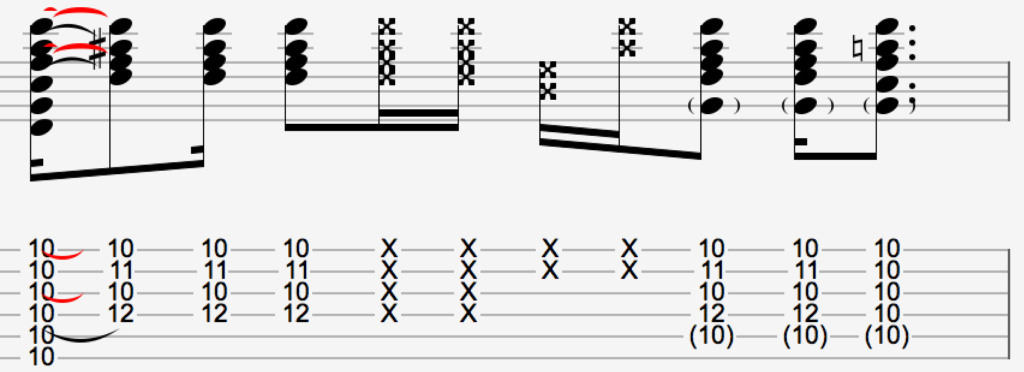Rhythm Skills: Learn The Doobie Brothers Long Train Running
“Long Train Running” is one of my favorite Doobie Brothers songs.
This is one of these songs that will do wonders for your time-feel and rhythm-playing skills.
There are 3 main parts
- The main Gm7 chord funky rhythm part
This is actually 2-3 overdubbed guitars.
One of these guitars plays the mutes. It’s fun to combine the 2 electric guitars, including the one with the mutes, into 1 part. - 2 bars of C minor
Going from 1 bar Cm7 followed by 1 bar Cm13 - Eb Eb/D D
I’m going to show 2 different guitar parts you could play over this
Later in the song, there are rhythmic breakdowns.
The Gm Funky Part
This specific chord idea of hammering these 2 notes while the pointy finger is barring strings, as transcribed in the below tab, is a typical classic rock chord thing.
Some songs that come to mind that use this exact same chord idea are Free’s “All Right Now” and Dire Straits (Mark Knopfler”s) “Sultans of Swing”.
The only difference is that in “Long Train Running”, the guitarist bars and hits all 6 strings on the first chord, while that chord idea is usually only played on the top 4 strings.
I only realized that the guitarist hits all 6 strings in this song after I slowed down the recording and isolated that guitar part in the mix.
Keep in mind: music notation of such rock guitar rhythm accompaniments can oftentimes be a tad bit arbitrary.
As is the case here too: the notation is a guide, not the bible.
Meaning: nobody will be able to tell if you for example miss the low E string in the first chord hit, or if you only hit 3 or 4 strings in the last 2 chord hits.
It’s about getting the feel right and about getting the part to sound and feel as close as possible to the recording.
Paradoxically: when it comes to rhythm and/or chordal guitar parts, you sometimes get it to sound closer to the original if you refrain from trying to hit every note perfectly as notated, in favor of playing freely and mimicking the sound of the recording as perfectly as you can.
Here’s the part:

(Check the video at the end of the blog to see how to play these guitar parts.)
The 2 Bars of Cm

Eb Eb/D D
This part shows amazing songwriting.
This is a really cool chord concept
It starts with an Eb chord, then while the Eb chord keeps sustaining, the bass underneath the chord moves a half step down from Eb to D, giving you an Eb/D chord, THEN the rest of the chord moves down to a D chord.
You can see in the video below how to play that.
I have also seen someone play this following part instead, which is kinda cool too.

This is actually the same as what I explained above, but the difference is that the moving Eb to D note is located not in the bass but at the top of the chord.
In this example, it goes from an Eb chord, then the Eb note (top note in the chord now) moves down a half step to D, and then the rest of the chord moves down a half step to a D chord.
The same idea, just arranged differently.
I personally prefer playing it where the bass motion happens in the bass.
Break Down Parts
The first breakdown is at 1:07
The way you play this: bar the top 4 strings on the 10th fret. Hit that chord.
This is an F6 chord
You can see the chord transcribed here.

Then add in the 2 remaining fingers to make it a Gm7 chord

Hit both these chords once back to back, repeat that 4x
This is followed by the Cm part, then the Gm part, then the Eb E/D D part, then the harmonic solo over the whole song form.
Followed by the 2nd breakdown is at 1:55 (same as previous break down)
3rd Breakdown is at 2:20
This one is slightly different: the pattern is 3 quarter notes followed by two 8th notes on beat 4 –> Gm Gm Gm Gm F6 all downstrokes.
The final rhythmic breakdown happens on Eb Eb/D D at 2:37
This walks down to a Cm chord on 2:41 followed by some Hendrix-y hammer-on chord embellishments.
Here’s a video showing how to play all the above guitar parts.
Conclusion
Hit me up anytime at vreny@zotzinmusic.com if you have any questions, or if you would like to book a lesson.
The free lessons I offer on my blog are cool, but you will never experience the progress, joy, and results that my students experience in lessons when you’re learning by yourself from blogs and videos.
That is why people take lessons: way better results and progress, much more complete information, exposed to way more creative ideas than you can get from a blog or YouTube video.
There is only so much that self-study can accomplish.
If you want to see amazing results and progress in your guitar playing, buy your first lesson here and get started ASAP.
You’ll impress your friends and loved ones in no time with your guitar playing!
Consider donating any small amount to help me keep this blog going.
Thank you for your support!


